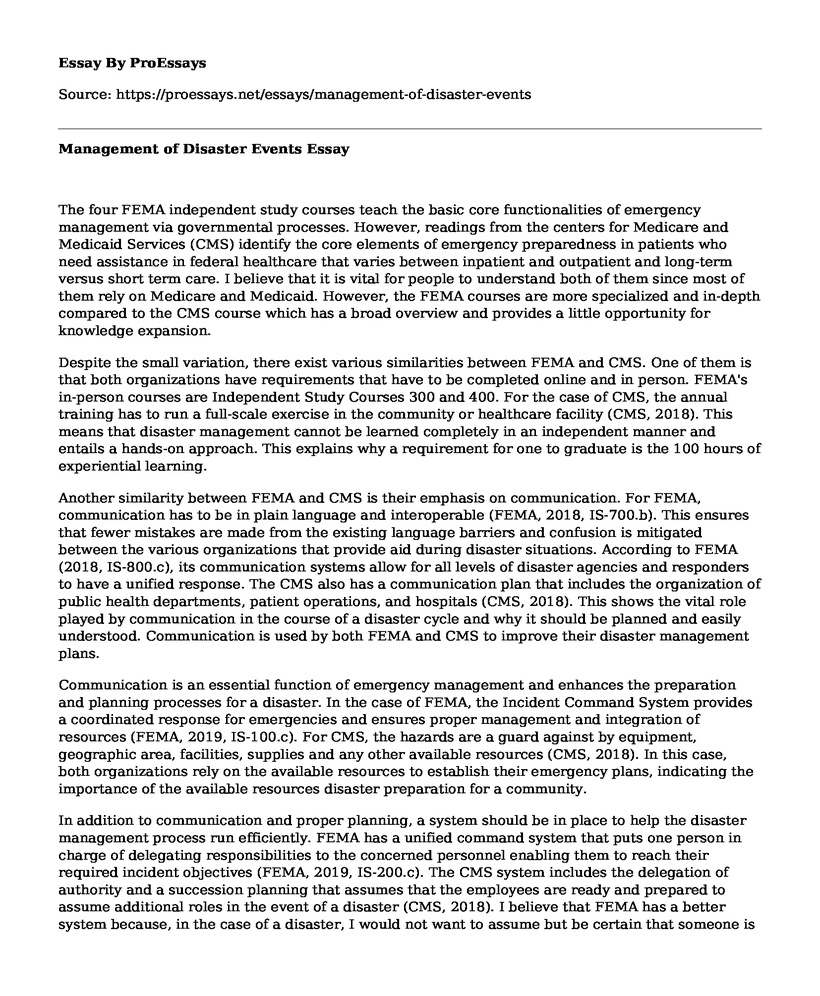The four FEMA independent study courses teach the basic core functionalities of emergency management via governmental processes. However, readings from the centers for Medicare and Medicaid Services (CMS) identify the core elements of emergency preparedness in patients who need assistance in federal healthcare that varies between inpatient and outpatient and long-term versus short term care. I believe that it is vital for people to understand both of them since most of them rely on Medicare and Medicaid. However, the FEMA courses are more specialized and in-depth compared to the CMS course which has a broad overview and provides a little opportunity for knowledge expansion.
Despite the small variation, there exist various similarities between FEMA and CMS. One of them is that both organizations have requirements that have to be completed online and in person. FEMA's in-person courses are Independent Study Courses 300 and 400. For the case of CMS, the annual training has to run a full-scale exercise in the community or healthcare facility (CMS, 2018). This means that disaster management cannot be learned completely in an independent manner and entails a hands-on approach. This explains why a requirement for one to graduate is the 100 hours of experiential learning.
Another similarity between FEMA and CMS is their emphasis on communication. For FEMA, communication has to be in plain language and interoperable (FEMA, 2018, IS-700.b). This ensures that fewer mistakes are made from the existing language barriers and confusion is mitigated between the various organizations that provide aid during disaster situations. According to FEMA (2018, IS-800.c), its communication systems allow for all levels of disaster agencies and responders to have a unified response. The CMS also has a communication plan that includes the organization of public health departments, patient operations, and hospitals (CMS, 2018). This shows the vital role played by communication in the course of a disaster cycle and why it should be planned and easily understood. Communication is used by both FEMA and CMS to improve their disaster management plans.
Communication is an essential function of emergency management and enhances the preparation and planning processes for a disaster. In the case of FEMA, the Incident Command System provides a coordinated response for emergencies and ensures proper management and integration of resources (FEMA, 2019, IS-100.c). For CMS, the hazards are a guard against by equipment, geographic area, facilities, supplies and any other available resources (CMS, 2018). In this case, both organizations rely on the available resources to establish their emergency plans, indicating the importance of the available resources disaster preparation for a community.
In addition to communication and proper planning, a system should be in place to help the disaster management process run efficiently. FEMA has a unified command system that puts one person in charge of delegating responsibilities to the concerned personnel enabling them to reach their required incident objectives (FEMA, 2019, IS-200.c). The CMS system includes the delegation of authority and a succession planning that assumes that the employees are ready and prepared to assume additional roles in the event of a disaster (CMS, 2018). I believe that FEMA has a better system because, in the case of a disaster, I would not want to assume but be certain that someone is going to help.Conclusion
To conclude, there exist many similarities amongst organizations' core management functions in the event of emergencies. However, organizations should have a backup plan if one approach fails. The main take away from the readings is that for proper emergency management, there needs to be proper planning and preparation, appropriate and effective communication and additional hands-on learning approach. While both models are adequate for learning and training on emergency management, FEMA is more specialized and in-depth.
References
"Centers for Medicare and Medicaid Services." (2018). Core-EP-Rule-Elements. Retrieved from https://www.cms.gov/Medicare/Provider-Enrollment-and-Certification/SurveyCertEmergPrep/Core-EP-Rule-Elements.html
FEMA (2018). An Introduction to the National Incident Management System, IS-700.b. Emergency Management Institute. Retrieved from https://training.fema.gov/is/crslist.aspx
FEMA (2018). Introduction to the Incident Command System, IS-100. Emergency Management Institute. Retrieved from https://training.fema.gov/is/crslist.aspx
FEMA (2018). National Response Framework, an Introduction, IS-800.c. Emergency Management Institute. Retrieved from https://training.fema.gov/is/crslist.aspx
FEMA (2019). Basic Incident Command System for Initial Response, IS-200.c. Emergency Management Institute. Retrieved from https://training.fema.gov/is/crslist.aspx
Cite this page
Management of Disaster Events. (2022, Mar 28). Retrieved from https://proessays.net/essays/management-of-disaster-events
If you are the original author of this essay and no longer wish to have it published on the ProEssays website, please click below to request its removal:
- Research Paper on Thyroid Cancer
- Ethical Issues in Counseling Essay
- Fire Incidence on Carnival's Cruise Ship "Splendor" Essay Example
- Dissemination for Evidence-Based Interventions: Poster Presentations - Essay Sample
- Essay on Rhetorical Strategies and Fallacies in President Obama's Call for Health Reform Mobilization
- Essay Example on Health Care, Social Justice, and Ms. Lauder
- Essay Example on Language Barrier Overcome: My Most Notable Nursing Experience







